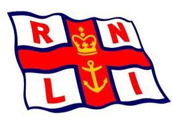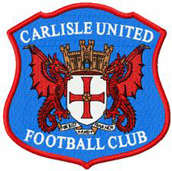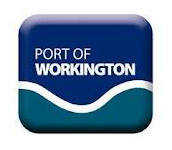- Home
- Scarrows
- Mariners
- Cumberland
- Miscellaneous
New Orleans
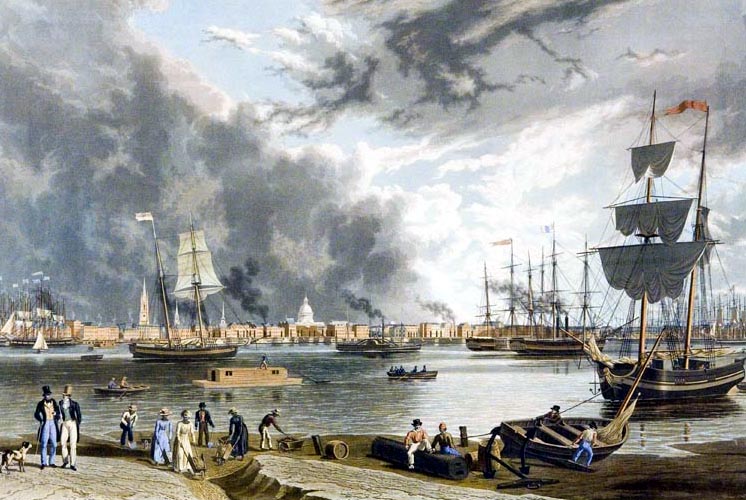
New Orleans 1841
History
The French had established themselves in the Canada in the mid-seventeenth century by securing control of the St. Lawrence and the Great Lakes. The French sought to limit the English to the eastern coast of the continent by claiming the Mississippi and its tributaries, thereby gaining control of the interior of North America. The key to securing the Mississippi was to control access to its mouth on the Gulf of Mexico, but the French explorers discovered there was a problem. From the mouth of the Mississippi to a point about 200 miles upstream (Baton Rouge), there was no ground high enough to provide a natural site for a city. While the great river demanded a splendid port city, it seemed to provide no place for one.
The French had soon realized that their forts along the Gulf Coast were unable to assure control of the Mississippi. A garrison town near the mouth of the river with a shorter backdoor route to the Gulf that could be protected by forts would assure control of the river and the lower Mississippi Valley. In 1718 Jean Baptiste La Moyne, Sieur de Bienville, established New Orleans as the capital of Louisiana and a fortress to control the wealth of the North American interior. From 1718 until 1810, New Orleans was essentially European in its physical shape and design and in human orientation. Decreed a city at its founding by Bienville in 1718, New Orleans was laid out by the French engineer, Adrien de Pauger, in a classic eighteenth-century symmetrical gridiron pattern. The plan with its central square, church, walls and towers embodied the eighteenth-century Enlightenment ideal of the perfect city implanted in the New World; but the reality was otherwise. For many years, the walls were only straggling wooden palisades, the square was choked with weeds, most buildings -- including the church -- were simple, wooden structures, and the streets were little more than muddy ruts. Yet none of this mattered, nor did the fact that there were not enough people to fill the grid until 1800. What mattered was that from the beginning, New Orleans had a reputation as a very important place; and for most of the eighteenth century, image was more important that reality.
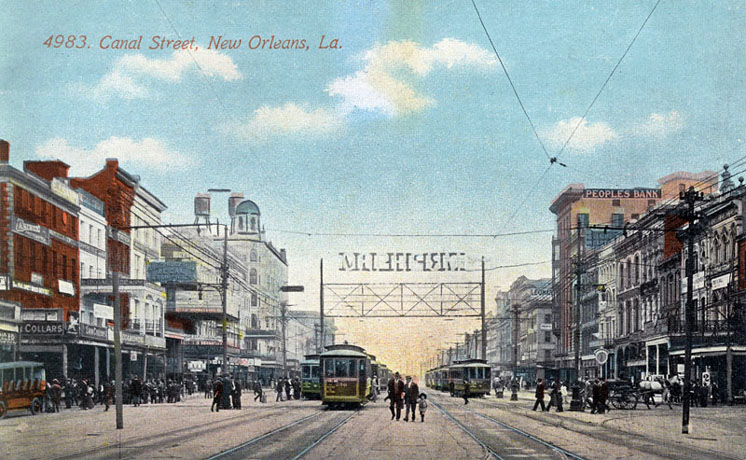
The forty-five years of French rule were the slowest and most painful for New Orleans. The reason for this had to do as much with the French attitude towards emigration as it did with the economic policies of the French Crown. In Louisiana, as in Canada, the French failed to populate their territories adequately. The Bourbon government feared heretics and Englishmen (the two, often synonymous in French minds), and preferred conservative, Catholic Frenchmen as settlers. All settlers were screened carefully, but most conservative Catholic Frenchmen much preferred France to the Mississippi Delta. The French who did emigrate were suspicious of outsiders; and, the rural Acadians ("Cajuns") who settled the countryside around New Orleans in the 1760's, after being hounded out of Canada, especially disliked Protestants and Englishmen. France's economic policy -- mercantilism -- also worked against rapid growth. Mercantilism essentially held that all economic activity should be regulated by the state for the benefit of the state. Thus, colonies existed solely for the benefit of the state, providing the mother country with raw materials and markets for finished goods -- i.e., a minimum investment in, but a maximum return for the colonies. For most of her rule, France saw little indication of large financial returns from her Louisiana colony. The French thought of Louisiana and the Mississippi Valley as a buffer against British expansion westward from their seaboard colonies, and as a challenge to Spanish predominance in the west and southwest of North America. France, then, saw no point in investing large sums in Louisiana, except for the brief period from 1716-1722, that saw the founding of New Orleans.

New Orleans circa 1800
Defeated in the Seven Years War (1756-63), France was compelled by the Treaty of Paris to cede Canada and all the territory between the Appalachians and the Mississippi, including West Florida and Louisiana, north of Lake Pontchartrain, to Britain. The rest of Louisiana, including New Orleans, was handed over to the Bourbons of Spain. Spain's 41-year rule was ultimately beneficial to New Orleans, but for reasons only indirectly related to Spanish ownership and economic policies. Plagued with even worse domestic problems than France and with growing unrest throughout her extensive, but tottering, empire in Central and South America, Spain was too preoccupied to see New Orleans as anything more than a sideshow. Not until 1769 did the French population even acknowledge Spanish rule, and then only when faced with a Spanish military force. New Orleans was never really integrated into Spain's Empire, although shippers and merchants were allowed to trade with Spain and France and their colonies in the Caribbean.
New Orleans did grow under Spanish rule, primarily because of English Colonial and then American settlement of the Ohio Valley. Spain was as nervous as the French had been about the English colonists and the British. It was obvious after 1763 that New Orleans' close geographical ties to the British colonies in North America were pulling the city into what would later become the American orbit. Anglo settlers in the Ohio Valley sought trade outlets through the city, an within New Orleans itself, the direction of growth was upriver. The Spanish at first allowed Colonial and British traders to undertake much of the high risk commercial shipping on which New Orleans depended; but in the late 1770's, a worried Spain revoked Colonial and British trading privileges. However, the Anglo-Saxons, established in West Florida (north of Lake Pontchartrain) continued to ship goods through Lakes Borgne, Pontchartrain and Maurepas, setting up a thriving entrepot at Pass Manchac. The Spanish soon realized that this thriving, but illicit trade between the Anglo and the Latin commercial interests in the city was absolutely essential for moving goods in and out of New Orleans. Spain and her empire were unable to supply the necessary provisions to New Orleans or sufficient markets for the products of the Mississippi Valley.
With the American Revolution and the establishment of the United States, American involvement in trade with and through New Orleans grew at a rate that increasingly alarmed the Spanish. Spain worried that New Orleans' rapidly growing economy was tied too directly to the new United States, but her final efforts to stem the American flood backfired. Measures such as offering enhanced trading privileges to Americans who would accept Spanish citizenship in New Orleans only increased the inevitable linkages between New Orleans and the American economy.
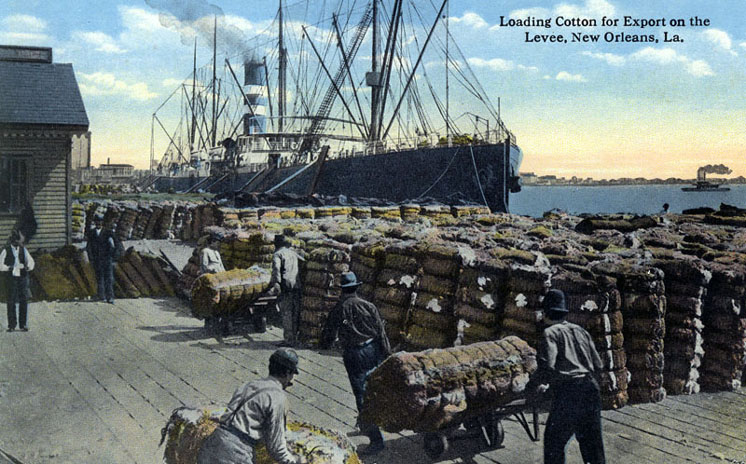
Both Spain and France proved unable to hold New Orleans as part of an empire against the Americans flooding into the Mississippi Valley after 1800. As the nineteenth century began, France was completing her revolution and was periodically at war with half of Europe; and Bourbon rule in Spain and throughout Latin America was near collapse. Napoleon tried to reestablish the French Empire in Louisiana, taking control of New Orleans from Spain in 1802; but financial troubles and the difficulty of holding French conquests in Europe and the Caribbean led him to sell all of Louisiana, including New Orleans, to the United States. The restored French rule had been brief; on December 1, 1803, official word of French ownership reached New Orleans. A scant three weeks later came news that Louisiana and New Orleans were American. Thomas Jefferson, who negotiated the "Louisiana Purchase," had pulled off one of the great real estate buys in history.
The addition of Louisiana to the United States was inevitable. The young republic was moving inexorably westward, and its major transportation system for moving people and goods was the Ohio-Missouri-Mississippi river system. New Orleans was the natural outlet for the agricultural products and manufactured goods produced by the Americans flooding west of the Appalachians. Since there were too few Europeans to hold New Orleans against the American tide, it was New Orleans' destiny to become part of the United States. In December 1803, New Orleans' legal and political realities finally became aligned with its obvious geographic and economic realities as a critical part of a rapidly growing United States. New Orleans' situation was too important, its reputation too flamboyant to be ignored by the United States any longer. New Orleans' fate was determined by its particular political and economic conditions that dictated its founding as a city. These conditions dominated its economic development to the Civil War and have been influential ever since. New Orleans' situation on the Mississippi, the Industrial Revolution, international power struggles, and the emergence of the United States as a major power have embedded the city deep within the heartland of the American economy and have made it an important factor in the world economy.
Trade

During France's rule, New Orleans and the area upriver produced few goods that could be exported. A few lumber mills were built, and lumber, pitch, and other such products were exported. But lumber, while it might fill the ship's hold was usually much less valuable than the load of incoming necessities it replaced. For a while, ships were required by law to accept a certain amount of lumber products aboard before being permitted to leave port. Some indigo was exported from the plantations near New Orleans, and tobacco was grown on drier land upriver of Baton Rouge. Furs from trappers in the Midwest arrived in New Orleans along with some flour from Indians or settlers in Illinois. But flour was usually imported from Europe. So, throughout the French Period, a serious imbalance of trade existed between New Orleans and the outside world. Such a negative balance is typical of developing areas and is usually counter-weighted by an inflow of investment funds. The French, however, stung by the "Mississippi Bubble," saw little chance of profit from any investment in New Orleans.
Economic conditions improved under the Spanish, but not because of their attitude toward investment. Spanish colonial policy followed strict mercantilist lines. Spain sought the maximum expropriation of wealth, with minimum time and effort. Nevertheless, the years of Spanish rule, from 1762-1803, saw steady growth in commerce, mainly stimulated by British and Latin American businesses willing to speculate in bringing goods to New Orleans. After 1730, there was an increasing flow of agricultural products and even some manufactured goods down the Ohio and Mississippi River to New Orleans, both for export to Europe and for shipment to the eastern seaboard of the new United States. The technology of the day made water transportation the most efficient means of moving goods.
Two technological breakthroughs of the 1790's also dramatically altered the composition and quantity of trade through New Orleans. The first was planter Etienne Bore's introduction of an improved process for refining sugar, which led within one season to a wholesale substitution of sugar cultivation for indigo on the plantations surrounding New Orleans. The second was Eli Whitney's cotton gin which transformed the highly labor-intensive step of removing seeds from raw cotton into a speedy mechanical process. As cotton cloth became the nearly universal standard for wearing apparel, English factory demand for cotton greatly increased. Cotton quickly supplanted tobacco in the drier areas north of Baton Rouge. At the same time, rice continued to be cultivated in south Louisiana. By 1800, New Orleans had become a center for the preparation, storage, shipping, and financing of local sugar and rice crops, cotton from further up the river, and wheat and other products from the American midwest. Clearly, no matter what Spain's wishes or policy, New Orleans' natural economic development was tied to its position near the outlet of the greatest river in the United States.
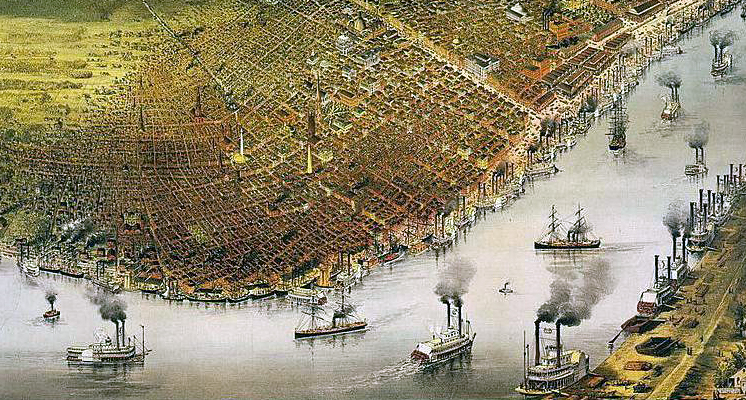
Aerial View of New Orleans 1885
The years from the Purchase to the Civil War were golden ones for New Orleans, witnessing intense growth and development and significant changes in the internal structure of its economy. In 1803, New Orleans was basically 8,000 people directly or indirectly tied to moving goods from river vessels to dock to ship and vice versa. Its primary industry was the port, moving and storing goods. Ship chandling, repairing, and building were a distant second industry, but rapid economic growth after 1803 spawned new economic interests. By the 1820's and 1830's, New Orleans was the commercial entrepot and financial intermediary for goods from all reaches of the Mississippi. There were many more merchants to handle the growing trade and the financing of farms, plantations, and communities upriver. There were growing wholesale, retail, an transient service sectors to supply the food, clothing, and goods of growing population of residents and visitors: and there was the inevitable growth of government to provide police, fire, and health services and to administer docks and levees.
In addition to the emergence of new economic sectors, the focus of New Orleans' economic activities began to change in the late 1830's. Until then, about 90% of the city's trade consisted of downriver shipments of Midwestern foodstuffs. In the 1830's and 1840's, the growing world demand for cotton led to the development of vast, efficient slave plantations in the lower Mississippi Valley that produced more cotton at lower prices. By the late 1840's cotton was king, and New Orleans and the Mississippi River planters were prosperous. Increased world demand for cotton had pushed New Orleans into a less national, more regional orientation and role. On the eve of the Civil War, port activity was way up, but more than ever it centered around the exportation of cotton and the importation of plantation-destined goods. Aiding this process was the completion of the Erie and other canals in the 1820's and 1830's which drained away much of the upper Midwest grain trade. But, as yet, the railroad did not threaten the city's cotton business as it would after the Civil War. In retrospect, the 1850's were the high water marks of cotton shipping, cotton culture, and cotton wealth in nineteenth century New Orleans.
In terms of trade, between 1821 and 1835, the average total of exports and imports per year through New Orleans was $22 million ($15 million exports, and $7 million imports), a fourfold increase in exports alone. The exports represented for the period 1821-35 about 18% of all United States exports, and for 1852-60, 30% of the same. Cotton shipment peaked during the 1860-61 season, totaling over 2,200,000 bales, worth $110,000,000 and representing 60% of the value of all products received from the upcountry. Sugar and tobacco were distant runners-up to cotton, and foodstuffs made up the bulk of the rest of the exports. Most of the cotton was shipped from New Orleans to Liverpool and other British ports, either directly, or by transhipment through New York. New Orleans, then, was a transhipment point for cotton, and the city never developed into a major manufacturing center for the primary products it transhipped, financed or stored.
Imports
| Goods | Place of Origin |
|---|---|
| Machinery | Britain |
Exports
| Goods | Destination |
|---|---|
| Cotton | Britain |
| Tobacco | Britain |
| Sugar | |
| Rice | |
| Indigo | Britain |
Industry
| Port Industries | Other Industries |
|---|---|
| Ship-building and repair | Machine Shops |
| Goods Storage | Iron Works |
Scarrow Associations
| Scarrow | Period |
|---|---|
| Thomas Scarrow | 1868 |
| Robert Scarrow | 1908, 1910-11, 1913, 1918-20, 1925, 1927, 1932, 1935-36, 1938 |

